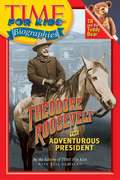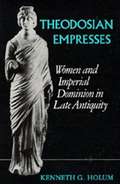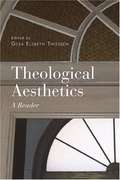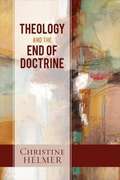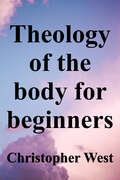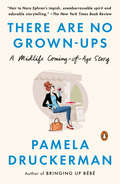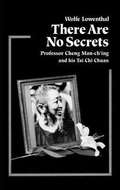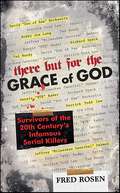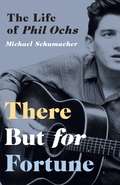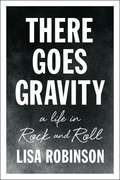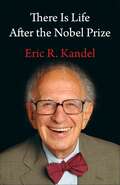- Table View
- List View
Theodore Roosevelt: The Adventurous President (First Edition)
by Lisa Demauro The Editors of Time For KidsEach day was an adventure for President Theodore Roosevelt. TIME For Kids Biographies help make a connection between the lives of past heroes and the events of today. When Teddy became president, Americans were looking ahead with excitement to the twentieth century. Teddy's spirit and dreams helped make the United States one of the greatest countries in the world.
Theodore the Great: Conservative Crusader
by Daniel RuddyTheodore Roosevelt has a complicated legacy. To some, he was the quintessential American patriot and hero, a valiant soldier who won the Congressional Medal of Honor. Others remember him as a cultural icon, the man who brandished a "big Stick," proclaimed the "Square Deal," led a "Strenuous Life," and inspired the "Teddy Bear." He was a farsighted conservationist who essentially founded the modern environmental movement. He was also a legendary hunter. Mark Twain once called him "insane." <P><P>So who was the real Teddy Roosevelt? <P><P>Daniel Ruddy’s new biography cuts through the impenetrable tangle of misconceptions and contradictions that have grown up over the last century and obscured our view of a man who remains perhaps the most controversial president in U.S. history. Avoiding the sins of hero worship and character assassination, Ruddy gives the public what is long overdue—a fair-minded and even-handed assessment of a misunderstood American icon.
Theodosia Burr: Teen Eyewitness to the Founding of the New Nation
by Karen Cherro QuiñonesTheodosia Burr, daughter of Vice President Aaron Burr, came of age in New York City when the New Nation was growing up. She attended the inauguration of President George Washington in 1789, was at her father's side on the campaign trail and at his inauguration in 1801, attended presidential addresses to Congress, and hosted the most prominent politicians and thinkers of her time. The Burrs' ideas about educating young women were revolutionary. Theodosia was an experiment in the equal treatment of women—regardless of social status—in education, family life, society, and the law. The family believed that women had an important role to play in the New Nation, and Theodosia was fully prepared. Based on research at libraries and archives, and from the rich body of letters Theodosia and her family left behind, this historical narrative introduces readers to a most unusual girl who pursued a radical new path for women.
Theodosian Empresses: Women and Imperial Dominion in Late Antiquity
by Kenneth G. HolumTheodosian Empresses sets a series of compelling women on the stage of history and offers new insights into the eastern court in the fifth century.
Theodosius II
by Christopher KellyTheodosius II (AD 408-450) was the longest reigning Roman emperor. Ever since Edward Gibbon, he has been dismissed as mediocre and ineffectual. Yet Theodosius ruled an empire which retained its integrity while the West was broken up by barbarian invasions. This book explores Theodosius' challenges and successes. Ten essays by leading scholars of late antiquity provide important new insights into the court at Constantinople, the literary and cultural vitality of the reign, and the presentation of imperial piety and power. Much attention has been directed towards the changes promoted by Constantine at the beginning of the fourth century; much less to their crystallisation under Theodosius II. This volume explores the working out of new conceptions of the Roman Empire - its history, its rulers and its God. A substantial introduction offers a new framework for thinking afresh about the long transition from the classical world to Byzantium.
Theologians You Should Know: An Introduction: From the Apostolic Fathers to the 21st Century
by Michael Reeves<p>Whether you realize it or not, you are the beneficiary of centuries of careful study and reflection on God's Word. The writings and teachings of figures from the past are crucial to what the church believes today. But just like intriguing guests of honor at a dinner party, these theologians can be intimidating to get to know. <p>Introducing you to the lives and thought of figures such as the Apostolic Fathers, Justin Martyr, Augustine, Thomas Aquinas, Martin Luther, John Calvin, Karl Barth, and others, this book makes the writings of these significant theologians accessible and approachable―opening up for you the riches of church history and enlarging your vision of God and his plan for the world.</p>
Theological Aesthetics: A Reader
by Gesa Elsbeth ThiessenThese engaging readings range broadly over themes at the intersection of religion and the arts, including beauty and revelation, the vision of God, artistic and divine creation, God as artist, images of God, the interplay of the senses and the intellect, human imagination, mystical writings, meanings of signs and symbols, worship, liturgy, doxology, the relationship of word and image, icons and iconoclasm, the role of the arts in twentieth-century theology, and much more.
Theology and the End of Doctrine
by Christine HelmerThis book is about the crisis brought about by doctrine's estrangement from reality--that is from actual lives, experiences, histories, and from God. By invoking "the end of doctrine," Christine Helmer opens a new discussion of doctrinal production that is engaged with the challenges and possibilities of modernity. The end of doctrine refers on the one hand to unquestioning doctrinal reception, which Helmer critiques, and on the other, represents an invitation to a new way of understanding the aim of doctrine in deeper connection to the reality that it seeks. The book's first section offers an analysis of the current situation in theology by reconstructing a trajectory of Protestant theology from the turn of the twentieth century to today. This history focuses primarily on the status of the word in theology and explains how changes in theology in the context of the political and social crisis in Europe in the 1920s and 1930s led to a distancing of the word from reality. Helmer then turns to the constructive section of the book to propose a repositioning of theology to the world and to God. Helmer's powerful work will inspire revitalized interest in both doctrine and theological inquiry itself.
Theology of the Body for Beginners: Rediscovering the Meaning of Life, Love, Sex, and Gender
by Christopher WestDivorce. Broken families. Sexual abuse. Addiction. Pornography. Same-sex "marriage." Gender issues. Everywhere we look, we find more and more confusion about the most fundamental truths of human life. As we lose our basic understanding of the meanings of man, woman, marriage, and sex, the question becomes ever more urgent: What does it mean to be a human being? Against this backdrop, St. John Paul II's Theology of the Body appears as a bright light in the darkness. His writings go straight to the heart of what it means to be fully human--but they are often difficult for most of us to grasp easily.
Theology's Epistemological Dilemma: How Karl Barth and Alvin Plantinga Provide a Unified Response (Strategic Initiatives in Evangelical Theology)
by Kevin DillertruthTheology's Epistemological Dilemma
Theory of Water: Nishnaabe Maps to the Times Ahead
by Leanne Betasamosake SimpsonAcclaimed Nishnaabeg writer Leanne Betasamosake Simpson takes a revolutionary look at that most elemental force, water, and suggests a powerful path for the future.For many years, Leanne Betasamosake Simpson has found refuge in skiing—in all kinds of weather across different forms of terrain, often following the trail beside a beloved creek near her home. Recently, as she skimmed along this path and meditated on our world's uncertainty—including environmental devastation, the rise of authoritarianism, and the effects of ongoing social injustice—her mind turned to the ice beside her, and the snow beneath her feet. And she asked herself: What might it mean to truly listen to water? To know not only the land on which we live, but the water that surrounds and inhabits us? To coexist with and alongside water? So begins this renowned writer's quest to discover, understand, and trace the historical and cultural interactions of Indigenous peoples with water in all its forms. On her journey, she reflects on the teachings, traditions, stories, and creative work of others in her community—particularly those of her longtime friend Doug Williams, an Elder whose presence suffuses these pages; reads deeply the words of thinkers from other communities whose writing expands her own; and begins to shape a "Theory of Water" that reimagines relationships among all beings and life-forces. In this essential and inventive work, Simpson artfully weaves Nishnaabeg stories with her own thought and lived experience—and offers a vision of water as a catalyst for transformation, today and into our shared future.
Theos Bernard, the White Lama: Tibet, Yoga, and American Religious Life
by Paul G. HackettThe life and adventures of an American explorer and iconic figure in the 20th century religious counterculture movement.In 1937, Theos Casimir Bernard, the self-proclaimed &“White Lama,&” became the third American in history to reach Lhasa, the capital city of Tibet. During his stay, he amassed the largest collection of Tibetan texts, art, and artifacts in the Western hemisphere at that time. He also documented, in both still photography and 16mm film, the age-old civilization of Tibet on the eve of its destruction by Chinese Communists. Based on thousands of primary sources and rare archival materials, this is the real story behind the purported adventures of Bernard and his role in the growth of America's religious counterculture. Over the course of his brief life, Bernard met, associated, and corresponded with the major social, political, and cultural leaders of his day, from the Regent and high politicians of Tibet to saints, scholars, and diplomats of British India, from Charles Lindbergh and Franklin Delano Roosevelt to Gandhi and Nehru. Although hailed as a brilliant pioneer by the media, Bernard also had his flaws. He was an entrepreneur propelled by grandiose schemes, a handsome man who shamelessly used his looks to bounce from rich wife to rich wife in support of his activities, and a master manipulator who concocted his own interpretation of Eastern wisdom to suit his ends. Bernard had a bright future before him but disappeared in India during the communal violence of the 1947 Partition, never to be seen again.&“Well-written…A readable intellectual account of the life of an ambitious Tibetological pioneer.&”—Asian Ethnology
Theos Bernard, the White Lama: Tibet, Yoga, and American Religious Life
by Paul HackettIn 1937, Theos Casimir Bernard (1908–1947), the self-proclaimed "White Lama," became the third American in history to reach Lhasa, the capital city of Tibet. During his stay, he amassed the largest collection of Tibetan texts, art, and artifacts in the Western hemisphere at that time. He also documented, in both still photography and 16mm film, the age-old civilization of Tibet on the eve of its destruction by Chinese Communists. Based on thousands of primary sources and rare archival materials, Theos Bernard, the White Lama recounts the real story behind the purported adventures of this iconic figure and his role in the growth of America's religious counterculture. Over the course of his brief life, Bernard met, associated, and corresponded with the major social, political, and cultural leaders of his day, from the Regent and high politicians of Tibet to saints, scholars, and diplomats of British India, from Charles Lindbergh and Franklin Delano Roosevelt to Gandhi and Nehru. Although hailed as a brilliant pioneer by the media, Bernard also had his flaws. He was an entrepreneur propelled by grandiose schemes, a handsome man who shamelessly used his looks to bounce from rich wife to rich wife in support of his activities, and a master manipulator who concocted his own interpretation of Eastern wisdom to suit his ends. Bernard had a bright future before him, but disappeared in India during the communal violence of the 1947 Partition, never to be seen again.Through diaries, interviews, and previously unstudied documents, Paul G. Hackett shares Bernard's compelling life story, along with his efforts to awaken America's religious counterculture to the unfolding events in India, the Himalayas, and Tibet. Hackett concludes with a detailed geographical and cultural trace of Bernard's Indian and Tibetan journeys, which shed rare light on the explorer's mysterious disappearance.
There Are No Grown-ups: A Midlife Coming-of-Age Story
by Pamela DruckermanThe best-selling author of BRINGING UP BÉBÉ investigates life in her forties, and wonders whether her mind will ever catch up with her face.When Pamela Druckerman turns 40, waiters start calling her "Madame," and she detects a new message in mens' gazes: I would sleep with her, but only if doing so required no effort whatsoever. Yet forty isn't even technically middle-aged anymore. And there are upsides: After a lifetime of being clueless, Druckerman can finally grasp the subtext of conversations, maintain (somewhat) healthy relationships and spot narcissists before they ruin her life. What are the modern forties? What do we know once we reach them? What makes someone a "grown-up" anyway? And why didn't anyone warn us that we'd get cellulite on our arms? Part frank memoir, part hilarious investigation of daily life, There Are No Grown-Ups diagnoses the in-between decade when... • Everyone you meet looks a little bit familiar. • You're matter-of-fact about chin hair. • You can no longer wear anything ironically. • There's at least one sport your doctor forbids you to play. • You become impatient while scrolling down to your year of birth. • Your parents have stopped trying to change you. • You don't want to be with the cool people anymore; you want to be with your people. • You realize that everyone is winging it, some just do it more confidently. • You know that it's ok if you don't like jazz. Internationally best-selling author and New York Times contributor Pamela Druckerman leads us on a quest for wisdom, self-knowledge and the right pair of pants. A witty dispatch from the front lines of the forties, THERE ARE NO GROWN-UPS is a (midlife) coming-of-age story--and a book for anyone trying to find their place in the world.
There Are No Secrets: Professor Cheng Man-ch'ing and his Tai Chi Chuan
by Wolfe LowenthalThis book is a light-hearted recounting of the life of the late Professor Cheng M'an Ching. The author describes the time he spent at Professor Cheng's New York Tai Chi studio, and some of the lessons learned.
There But For the Grace of God: Survivors of the 20th Century's Infamous Serial Killers
by Fred RosenThey stared into the faces of pure evil . . . and survived!Ted Bundy . . . Jeffrey Dahmer . . .David "Son of Sam" Berkowitz . . . Dennis Rader, the BTK Killer . . .These are some of the names that strike terror into even the bravest of hearts. Human monsters, they preyed upon the unsuspecting, freely feeding their terrible hungers. Their crimes were unspeakable, as they maimed, tortured, killed, and killed again, leaving so many dead in their bloody wake. But somehow, astonishingly, seven would-be victims fell into the clutches of the century's worst serial killers—and escaped death through courage, divine providence, or just plain luck.This is the remarkable true story of those who lived.
There But for Fortune: The Life of Phil Ochs
by Michael SchumacherThe life and influence of singer Phil Ochs Phil Ochs burst onto the American music scene just as the popularity of folk music was breaking through on the national consciousness. Along with friend and rival Bob Dylan, Ochs wrote some of the most compelling topical music of his time. In There But for Fortune, Michael Schumacher explores the life and career of a singer, songwriter, and political activist whose music resonates today as much as it applied to a divided country a half-century ago. His politically charged songs were covered by Pete Seeger; Joan Baez; Gordon Lightfoot; Peter, Paul and Mary; and a host of others, and such songs as &“I Ain&’t Marching Anymore&” and &“The War Is Over&” became anthems of the anti–Vietnam War movement. He seemed to be performing everywhere, from concerts on college campuses to huge demonstrations, culminating with an appearance at the Democratic National Convention in Chicago in 1968.But as this biography illustrates in painstaking detail, Ochs suffered from a dark side that gravely affected his life and music. Diagnosed as manic depressive, he shifted between incredible highs and debilitating lows that ultimately drove him to suicide at age 36. To piece together his life story, Schumacher interviewed Ochs&’s friends, family members, and fellow musicians; examined his journals and scrapbooks; and even scrutinized his FBI files. While Phil Ochs&’s life might have been plagued by downturn and tragedies, his music is an enduring call to activism and fighting for a better future.
There Goes Gravity
by Lisa RobinsonFrom a legendary music journalist with four decades of unprecedented access, an insider's behind-the-scenes look at the major personalities of rock and roll.<P><P> Lisa Robinson has interviewed the biggest names in music--including Led Zeppelin, the Rolling Stones, John Lennon, Patti Smith, U2, Eminem, Lady Gaga, Jay Z and Kanye West. She visited the teenage Michael Jackson many times at his Encino home. She spent hours talking to John Lennon at his Dakota apartment--and in recording studios just weeks before his murder. She introduced David Bowie to Lou Reed at a private dinner in a Manhattan restaurant, helped the Clash and Elvis Costello get their record deals, was with the Rolling Stones on their jet during a frightening storm, and was mid-flight with Led Zeppelin when their tour manager pulled out a gun. A pioneering female journalist in an exclusive boys' club, Lisa Robinson is a preeminent authority on the personalities and influences that have shaped the music world; she has been recognized as rock jounralism's ultimate insider.<P> A keenly observed and lovingly recounted look back on years spent with countless musicians backstage, after hours and on the road, There Goes Gravity documents a lifetime of riveting stories, told together here for the first time.
There Goes My Social Life: From Clueless to Conservative
by Stacey DashIn 2012, actress Stacey Dash posted a tweet that changed her life. Up until that moment, Dash had lived a typical Hollywood life: Best known for playing Dionne in the 1995 teen classic Clueless, Dash had close friends in the upper echelons of the movie and music industries-and she had an Obama bumper sticker on the back of her BMW. But in 2012, sick of being disappointed by the Obama White House and growing more certain of her conservative beliefs, Dash endorsed Mitt Romney for president on Twitter. The backlash was swift and brutal.In There Goes My Social Life, Stacey Dash explains how she became a conservative, sharing incredible stories of her rough upbringing in South Bronx and her tumultuous Hollywood career to movingly illustrate her strong opinions about the value of a good education, the importance of family, the inanity of political correctness, and the power of personal responsibility.
There Goes Patti McGee!: The Story of the First Women's National Skateboard Champion
by Tootie Nienow2022 Texas Library Association's Texas Topaz Nonfiction Reading List PickTootie Nienow and Erika Medina's There Goes Patti McGee! is an uplifting picture book biography of the first-ever professional female skateboarder and winner of the 1964 National Skateboard Championship for Women.Brought to life by Erika Medina's dynamic and joyful illustrations, There Goes Patti McGee! walks us through Patti first place win in the women’s division of the 1964 National Skateboard Championship. She wowed the judges with what would become her signature move—the rolling handstand. Inspiring and unapologetic, Patti McGee proves that anyone can skate.
There I Am: The Journey from Hopelessness to Healing—A Memoir
by Ruthie Lindsey&“Ruthie is a gifted storyteller with the unique ability to make you feel her emotions as if they're your own. Her book is somehow both bold and tender and utterly, truthfully, authentically her. She doesn't hide from heartbreak or fail to experience the fullness of all the beauty life can hold.&” —Rachel Hollis, #1 New York Times bestselling author of Girl, Wash Your Face and Girl, Stop Apologizing Brain on Fire meets Carry On, Warrior, There I Am is an arresting inspirational memoir about one woman&’s journey from chronic pain and hopelessness to finding joy, redemption, and healing.At seventeen years old, Ruthie Lindsey is hit by an ambulance near her home in rural Louisiana. She&’s given a five percent chance of survival and one percent chance of walking again. One month later after a spinal fusion surgery, Ruthie defies the odds, leaving the hospital on her own two feet. Just a few years later, newly married and living in Nashville, Ruthie begins to experience debilitating pain. Her case confounds doctors and after numerous rounds of testing, imaging, and treatment, they prescribe narcotic painkillers—lots of them. Ruthie has become bedridden, dependent on painkillers, and hopeless, when an X-ray reveals that the wire used to fuse her spine is piercing her brain stem. Without another staggeringly expensive experimental surgery, she could well become paralyzed, but in many ways, she already is. Ruthie goes into the hospital in chronic pain, dependent on prescription painkillers, and leaves that way. She can still walk, but has no idea where she&’s going. As her life unravels, Ruthie returns home to Louisiana and sets out on a journey to learn joy again. She trades fentanyl for sunsets and morphine for wildflowers, weaning herself off of the drugs and beginning the process of healing—of coming home to her body. Raw and redemptive, There I Am is not just about the magic of optimism, but the work of it. Ruthie&’s extraordinary memoir urges us to unlearn the stories of brokenness that we tell ourselves and embrace the wholeness, joy, and healing that lives inside all of us.
There I Go Again: How I Came to Be Mr. Feeny, John Adams, Dr. Craig, KITT, and Many Others
by William DanielsThere I Go Again is a celebrity memoir like no other, revealing the life of a man whose acting career has been so rich that millions of Americans know his face even while they might not recognize his name. William Daniels is an enigma—a rare chameleon who has enjoyed massive success both in Hollywood and on Broadway and been embraced by fans of successive generations. Few of his peers inspire the fervor with which buffs celebrate his most iconic roles, among them George Feeny in Boy Meets World, KITT in Knight Rider, Dr. Mark Craig in St. Elsewhere, and John Adams in the play and film 1776. Daniels guides readers through some of Hollywood’s most cherished productions, offering recollections of entertainment legends including Lauren Bacall, Warren Beatty, Kirk Douglas, Michael Douglas, Audrey Hepburn, Marilyn Monroe, Mike Nichols, Jason Robards, Barbra Streisand, and many more. Looking back on his seventy-five-plus-year career, Daniels realizes that although he never had the courage to say “no” to being an actor, he backed into stardom. With his wife, actress Bonnie Bartlett, by his side, he came to realize that he wound up exactly where he was supposed to be: on the screen and stage.
There Is Life After the Nobel Prize
by Eric KandelOne day in 1996, the neuroscientist Eric R. Kandel took a call from his program officer at the National Institute of Mental Health, who informed him that he had been awarded a key grant. Also, the officer said, he and his colleagues thought Kandel would win the Nobel Prize. “I hope not soon,” Kandel’s wife, Denise, said when she heard this. Sociologists had found that Nobel Prize winners often did not contribute much more to science, she explained.In this book, Kandel recounts his remarkable career since receiving the Nobel in 2000—or his experience of proving to his wife that he was not yet “completely dead intellectually.” He takes readers through his lab’s scientific advances, including research into how long-term memory is stored in the brain, the nature of age-related memory loss, and the neuroscience of drug addiction and schizophrenia. Kandel relates how the Nobel Prize gave him the opportunity to reach a far larger audience, which in turn allowed him to discover and pursue new directions. He describes his efforts to promote public understanding of science and to put brain science and art into conversation with each other. Kandel also discusses his return to Austria, which he had fled as a child, and observes Austria’s coming to terms with the Nazi period. Showcasing Kandel’s accomplishments, erudition, and wit, There Is Life After the Nobel Prize is a candid account of the working life of an acclaimed scientist.
There Is No Alternative
by Claire BerlinskiGreat Britain in the 1970s appeared to a nation be in terminal decline-- ungovernable and rapidly headed for global economic irrelevance. Three decades later, it is one of the richest and most influential countries in Europe and Margaret Thatcher deserves all the credit. As journalist and conservative pundit Claire Berlinski shows, Thatcher's transformation of Britain was no simple task. Her jarring economic reforms often came at a high human cost as inefficient subsidies, welfare programs, and industries were abandoned entirely. While Thatcher's legacy has been the subject of passionate debate, Berlinski argues that we should be on her side. Socialism is on the rise and only countries willing to abide by Thatcher's philosophy will prevail. ""There Is No Alternative"" provides a valuable account of Margaret Thatcher's visionary triumphs in the fight for free enterprise.
